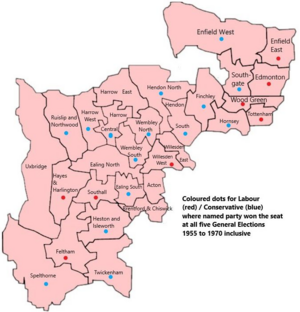Hornsey (UK Parliament constituency) facts for kids
Quick facts for kids {{{Name}}}[[{{{Type}}} constituency]] |
|
|---|---|
| [[Image:{{{Map1}}}Constituency.svg|120px|]] [[Image:England{{{Map2}}}.svg|120px|]] |
|
| {{{Name}}} shown within [[{{{Entity}}}]], and {{{Entity}}} shown within England | |
| Created: | {{{Year}}} |
| MP: | {{{MP}}} |
| Party: | {{{Party}}} |
| Type: | House of Commons |
| County: | [[{{{County}}}]] |
| EP constituency: | [[{{{EP}}} (European Parliament constituency)|{{{EP}}}]] |
Hornsey was an area in the UK that elected one person to be a Member of Parliament (MP). An MP represents their local area in the House of Commons, which is part of the UK Parliament. Hornsey was a constituency from 1885 until 1983. After 1983, most of its area became part of a new constituency called Hornsey & Wood Green.
Voters in Hornsey always used a system called first-past-the-post. This means the candidate with the most votes wins, even if they don't get more than half of all votes. In every election, the people of Hornsey chose a candidate from the Conservative Party. The closest election result was in 1966, when the Conservative candidate won by a very small margin of just 1.29%. After 1945, the Labour Party candidates usually came in second place.
Contents
History of Hornsey's Political Area
From 1885 to 1918, Hornsey was known as a county division of Middlesex. This meant it was a rural or suburban area. In 1918, it changed to a parliamentary borough, which usually means it was a more built-up, urban area. From 1950 onwards, it was officially a borough constituency.
Where Was Hornsey?
The exact borders of the Hornsey constituency changed over time.
Hornsey's Borders: 1885–1918
During this period, the Hornsey constituency included the areas known as the Parishes of Hornsey (which included South Hornsey) and Finchley. It also covered parts of the Parliamentary Boroughs of the City of London, Finsbury, and Islington. This allowed some wealthy voters to choose which of these areas they wanted to vote in.
Hornsey's Borders: 1918–1974
For this time, the constituency was the same as the Municipal Borough of Hornsey. This local government area was removed in 1965 when Greater London was created. Hornsey then became part of the London Borough of Haringey.
Hornsey's Borders: 1974–1983
In its final years, the Hornsey constituency included specific parts of the London Borough of Haringey. These areas were called Central Hornsey, Crouch End, Fortis Green, Highgate, Muswell Hill, South Hornsey, Stroud Green, and Turnpike.
Who Represented Hornsey?
The table below lists the Members of Parliament (MPs) who represented Hornsey in the House of Commons. All of them were from the Conservative Party or the Unionist Party, which was closely linked to the Conservatives.
| Year | Member | Party | |
|---|---|---|---|
| 1885 | Sir James McGarel-Hogg | Conservative | |
| 1887 | Henry 'Inky' Stephens | Conservative | |
| 1900 | Charles Balfour | Conservative | |
| 1907 | Lawrence Dundas | Conservative | |
| 1916 | Kennedy Jones | Unionist | |
| 1921 | William Ward | Unionist | |
| 1924 | Euan Wallace | Unionist | |
| 1941 | Sir David Gammans | Conservative | |
| 1957 | Muriel Gammans | Conservative | |
| 1966 | Sir Hugh Rossi | Conservative | |
| 1983 | constituency abolished | ||
Images for kids




